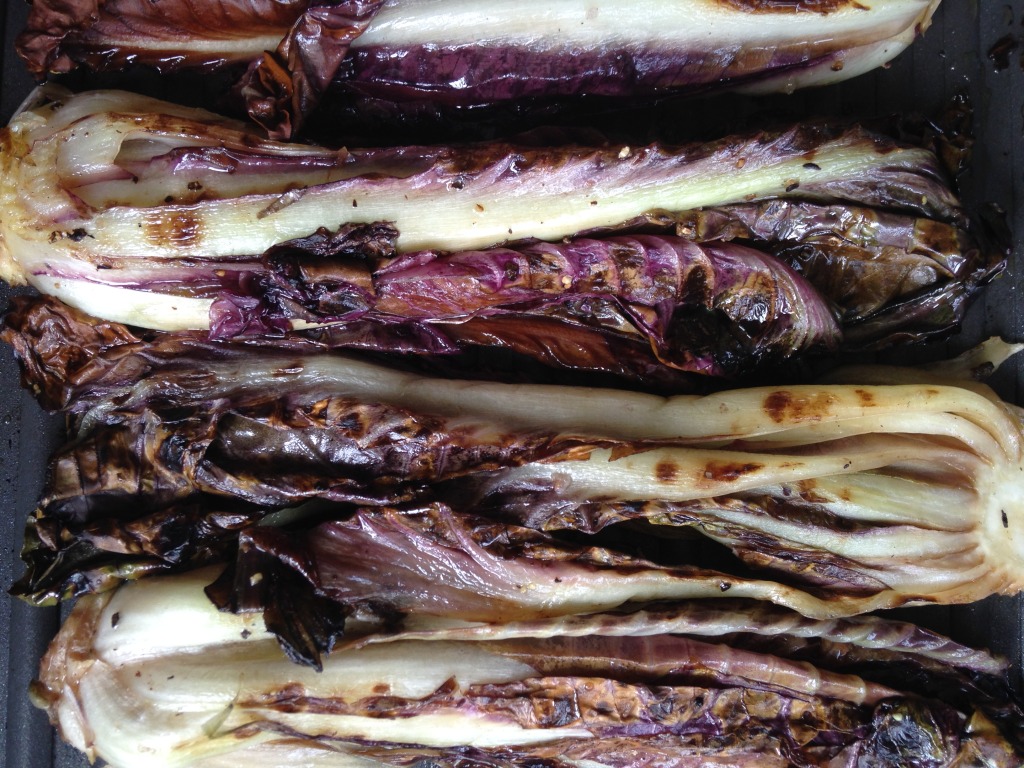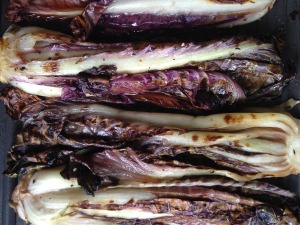Castelfranco, Chioggia, Palla Rossa, Treviso – The Queens of Chicory
I’ve been in love with radicchio, a member of the chicory family, since I first visited the huge, sandy production fields lying near the Adriatic Sea , just outside of Chioggia, Italy. I was taken there by a Dutch seedsman working for an Italian seed company. At that time, in the mid-1980s, radicchio production was still a hit and miss affair in the United States with large, forward-looking Salinas growers realizing its popularity in the new, ingredient-driven restaurants like Chez Panisse, and small farmers trying to figure out how to grow it as well. A Salinas company contacted Le Marché Seeds, which I owned with my partner, Charlotte Glenn, now Kimball, and asked if we could get some information for them. “It never turns red,” they told us. We had done some seed trials near Dixon, California and produced gorgeous magenta and white heads, but with some variation.
So, in order to learn more, we headed to the source: Italy and to our friend there, Hans Van der Meer. He was delighted to see us and made sure we stayed in a nice hotel in Cesena, where the seed company was located. He met us the next morning and drove us toward the Adriatic Sea to meet a radicchio farmer. When we arrived and looked out across the vast, sandy acreage dotted with round balls, some red, and some dark brown we were not sure what to think. On closer inspection, the dark brown balls were covered with brown, sliming, rotting leaves. Not appealing. Then the farmer bent down and pulled away the rot, revealing the desirable heads gleaming in red and white. We walked into the fields, Hans translating, as the farmer explained that radicchio didn’t like too much fertilizer, that it liked the cold, and that there were lots of different kinds, but the biggest market was for the red and white we were looking at.
More stunning than the fields was the warehouse we visited. The huge building was filled, floor to ceiling with bins of radicchio to be shipped all over Europe.
That night, Hans took us to dinner with the man who owned the warehouse, and we had, of course, radicchio salad to begin. It came to us in glass bowls, just radicchio leaves, one bowl for each of us. On the table sat a cruet of rich, dark green olive oil, a bowl of lemons, salt – maybe pepper and vinegar. I followed the men’s example, pouring oil and squeezing lemon over my leaves, adding a little salt, then tossing it with my fork.That is still the way I make it at home, but I add pepper too.
That was many years ago, and Salinas now growers produce radicchio by the tons. Radicchio is commonplace in supermarkets and ubiquitously present in bags of mixed greens. Trader Joe’s has its own mix. Recipes incorporating radicchio abound in food magazines, newspaper food sections, and cookbooks. I’ve written more than a few myself.
Yet I never grow tired of radicchio’s slightly bitter tastes, its affinity for strong, robust flavors, nor do I tire of growing it.
Since those early days, I’ve discovered the pink and pale green, speckled Chioggia variety and the darker rose-speckled Castelfranco, and red and white Treviso. These, along with Palla Rossa, are my favorites. I’m delighted that my market-grower neighbor, Nigel Walker of Eatwell Farms took my suggestion a few years back and tried growing some of these.
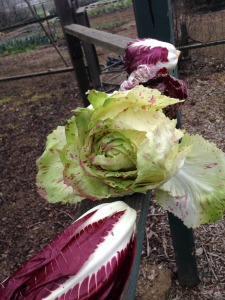
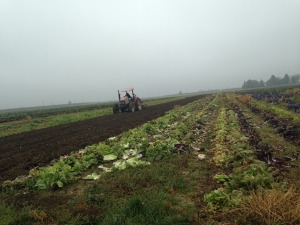 Last week I visited him and, as in Chioggia so long ago, walked the fields with him. It wasn’t the same as my Italian experience – dark, crumbly earth instead of sandy soil, green grass coming up here and there and no sight of the sea and, in addition to the round, red and white heads, he was also growing the tub-like Palla Rossa, glorious heads of Chioggia and Castelfranco, and large, upright heads of Treviso.
Last week I visited him and, as in Chioggia so long ago, walked the fields with him. It wasn’t the same as my Italian experience – dark, crumbly earth instead of sandy soil, green grass coming up here and there and no sight of the sea and, in addition to the round, red and white heads, he was also growing the tub-like Palla Rossa, glorious heads of Chioggia and Castelfranco, and large, upright heads of Treviso.
RECIPES
Risotto with Taleggio, Radicchio, and Red Wine
In this truly refined and elegant dish, the rice absorbs the wine along with the broth, and the seared radicchio, with its characteristic bitter taste is balanced by the rich Teleggio. With the first taste you will feel that you have stumbled into an Italian restaurant in Northern Italy, where risotto is made in multiple ways. The only trick to making this is to gently swirl in the cheese just before serving. For a visual flourish, the dish should come to the table with a creamy white swirl of cheese showing, but it makes no difference to the flavor and texture if the cheese is fully incorporated. From Cheese Obsessions by Georgeanne Brennan, Weldon Owen- Williams-Sonoma/
1 tablespoon extra virgin olive oil
2 cups shredded radicchio, about 1 small head
2 cups chicken broth
2 cups beef broth
2 tablespoons butter
1/2 onion, finely chopped, about 1/2 cup
2 cups Arborio rice
2 cups red wine
6 ounces Taleggio, rind removed and cut into small pieces
Kosher or sea salt
1/2 teaspoon freshly ground black pepper
In a frying pan over medium high heat, heat the olive oil. Add the radicchio, and sauté, stirring often, until the edges are golden, about 4 minutes. Set aside on paper towels to drain.
In a sauce pan, combine the broths and bring to a simmer over medium heat. Reduce to low.
In another saucepan, melt the butter over medium high heat. When it foams, add the onion and sauce until translucent, about 2 minutes. Add the rice, and stir, cooking, until the rice becomes opaque, about 2 minutes. Add the wine a little at a time, stirring, until the rice has absorbed most of the wine, about 5 or 6 minutes. Reduce the heat to medium and add the warm broth about 3/4 cup at a time, adding more only when the rice has absorbed most of the liquid. In about 20 minutes, the rice will be tender to the bite and most of the liquid absorbed. Stir in the radicchio, cheese, and the remaining butter. The rice will be creamy. Taste for salt and add as desired. Stir in the pepper and serve hot.
Serves 6 to 8
Grilled Treviso
These large heads, often the size of romaine, are ideal for grilling. As they char and darken, their inherent sugar caramelizes a bit, balancing the bitter taste. I serve this to accompany grilled steaks.
1 large head Treviso
3 to 4 tablespoons extra-virgin olive oil
1 tablespoon coarse sea salt
1 teaspoon freshly ground black pepper
Cut the Treviso lengthwise into 3 or 4 pieces. It is essential that each piece have a bit of the stem end to hold the leaves intact.
Lay the pieces in a baking dish large enough to hold them in a single layer. Pour over the olive oil and sprinkle with the salt and pepper and turn gently to coat.
Prepare a charcoal fire in a grill or preheat a gas grill. (or use a stovetop grill pan, getting it nice and hot before adding the radicchio). When the grill is hot, add the seasoned Treviso and grill until lightly golden about 3 minutes. Turn and repeat on the other side. Remove.
Serve hot, warm or at room temperature.
Serves 3 to 4
Here is a link to the San Francisco Chronicle’s recent story on Chicories
http://www.sfchronicle.com/recipes/article/Curl-up-with-winter-s-greens-chicory-6021345.php#/0 (It may or may not require a subscription to view)
BITS AND PIECES
Shopping and cooking
If you haven’t yet visited my on-line store, www.lavierustic.com, please do. You’ll find garden seeds (chicories included, of course) a new fruit-infused salt, this one, Sel d’Agrume, with blood orange and Meyer lemon zest made from the fruit of my own trees. Look under blogs, The Season of Citrus, to find out more about it and to discover citrus recipes as well. You’ll also find Elaine Corn’s beautiful gratin dish, hand made exclusively for La Vie Rustic. There are selling quickly, but there are still a few left.
And, here is a link to my recent blog on Gratins and their Special Dishes, with a recipe for Leek Gratin and Cauliflower Gratin with St. Marcellin Cheese (and bacon and caramelized onions)
https://lavierustic.com/savory-gratins-and-their-special-dishes/
COOKING CLASS MARCH 12, 2105
Yes, I’ve been convinced to give a cooking class by my friend Charles Vollmar, owner of Epicurian Exchange in Orinda, California. The class will include a gift from La Vie Rustic, although I haven’t decided what yet.
Menu: Artichoke Barrigoule with Crab Croquettes – Wine: Vermentino from Sicily • Leek Gratin with French Lettuces and Meyer Lemon Vinaigrette • Orange Confit of Belgian Endive and Seared Scallops –Wine: Marsanne and Rousanne blend from the Luberon or St. Joseph • Walnut and Almond Tart with Vanilla Crème Fraiche
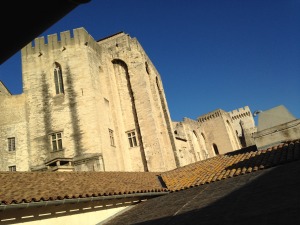 At the right is a view of the Papal Palace from La Mirande in Avignon. The scallop dish for the cooking class is my version of a wonderful dish I had at La Mirande this past December.
At the right is a view of the Papal Palace from La Mirande in Avignon. The scallop dish for the cooking class is my version of a wonderful dish I had at La Mirande this past December.
Leek Gratin – well, check my Gratin blog with photo and you’ll see why I’m making it. Artichokes will be in full swing in March and we’ll still have local crab. Walnut and Almond Tart makes a good conclusion to a meal this time of year, before the stone fruits are ready.
www.epicurianexchange.com to register for the cooking class or for more information.

